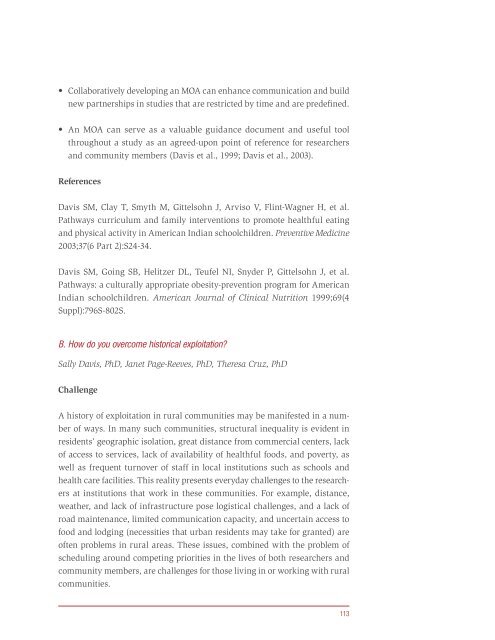Principles of Community Engagement (Second Edition)
Principles of Community Engagement (Second Edition)
Principles of Community Engagement (Second Edition)
Create successful ePaper yourself
Turn your PDF publications into a flip-book with our unique Google optimized e-Paper software.
• Collaboratively developing an MOA can enhance communication and build<br />
new partnerships in studies that are restricted by time and are predefined<br />
• An MOA can serve as a valuable guidance document and useful tool<br />
throughout a study as an agreed-upon point <strong>of</strong> reference for researchers<br />
and community members (Davis et al , 1999; Davis et al , 2003)<br />
References<br />
Davis SM, Clay T, Smyth M, Gittelsohn J, Arviso V, Flint-Wagner H, et al<br />
Pathways curriculum and family interventions to promote healthful eating<br />
and physical activity in American Indian schoolchildren Preventive Medicine<br />
2003;37(6 Part 2):S24-34<br />
Davis SM, Going SB, Helitzer DL, Teufel NI, Snyder P, Gittelsohn J, et al<br />
Pathways: a culturally appropriate obesity-prevention program for American<br />
Indian schoolchildren American Journal <strong>of</strong> Clinical Nutrition 1999;69(4<br />
Suppl):796S-802S<br />
B. How do you overcome historical exploitation?<br />
Sally Davis, PhD, Janet Page-Reeves, PhD, Theresa Cruz, PhD<br />
Challenge<br />
A history <strong>of</strong> exploitation in rural communities may be manifested in a number<br />
<strong>of</strong> ways In many such communities, structural inequality is evident in<br />
residents’ geographic isolation, great distance from commercial centers, lack<br />
<strong>of</strong> access to services, lack <strong>of</strong> availability <strong>of</strong> healthful foods, and poverty, as<br />
well as frequent turnover <strong>of</strong> staff in local institutions such as schools and<br />
health care facilities This reality presents everyday challenges to the researchers<br />
at institutions that work in these communities For example, distance,<br />
weather, and lack <strong>of</strong> infrastructure pose logistical challenges, and a lack <strong>of</strong><br />
road maintenance, limited communication capacity, and uncertain access to<br />
food and lodging (necessities that urban residents may take for granted) are<br />
<strong>of</strong>ten problems in rural areas These issues, combined with the problem <strong>of</strong><br />
scheduling around competing priorities in the lives <strong>of</strong> both researchers and<br />
community members, are challenges for those living in or working with rural<br />
communities<br />
113

















